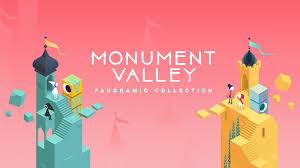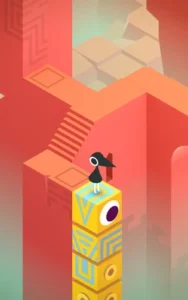
Monument Valley is a single-player puzzle game created by Ustwo Games, available on iOS, Android, Microsoft, and Windows. It’s target audience is for players aged 4+. Created in 2014, it has since won dozens of awards for its unique visuals and breathtaking design. Players guide Ida, a silent princess, through mazes of optical illusions and mind-bending architecture. Overall, the isometric nature of the puzzles, the slow movement/pace, and the delicious visuals/music create a meditative yet still engaging gaming experience for each player.
Each level takes place in a temple-like setting, each with a starting and ending point. The mechanics for the game are simple to learn. You can move Ida, the princess, to any square by simply tapping where you want her to go. The puzzle lies in how to change the architecture to create a path for Ida to get to the final spot. Players can move certain objects, indicated by small circular handles that cause the structures to either twist, turn, or slide. Some levels, you’ll move Ida onto a bridge and shift it to bring her to the other side; other levels involve rotating the entire building to see what other blocks can be moved from the other side. With each moved block, the architecture shifts in unexpected ways – optical illusions and perspective tricks become reality.

Progressing through levels involves a certain level of trial and error, as with any puzzle. The simplicity of the movement options creates a dynamic of exploration and experimentation for players of all ages. Each lever or button is made obvious, but the game counteracts this simplicity with the unexpectedness and delightfulness of how the particular block moves to align with another. In my experience playing Monument Valley, when I was stuck on a level, the reason was often due to an overlooked button or unmoved block.
Unlike other puzzle games where the outcome of each move is determinate (i.e. in Factory Balls, dipping into the blue paint can produce a known outcome of the ball becoming blue), players are never sure how a certain move can trigger a certain trick in perspective in Monument Valley. Through its illusory puzzles yet simple mechanics, the game is able to strike a wonderful balance of levels that may not be particularly difficult, but still intrigue and surprise its players in an almost meditative experience. The game also introduces a new game mechanic every 2 or 3 levels, which keeps the game progression fresh.

Monument Valley is the pinnacle of the aesthetic of sense pleasure. The beautiful color palette, from summery pastels to more ominous grays, is a pleasure to drink at each level. Even the music is on theme – some movements will trigger a flood of harp chords that adds to the mystical aura of Monument Valley.
One area that Monument Valley slightly lacks in is its narration. Ida occasionally meets characters along her journey, such as crows that stand in her way or a ghost-like figure named Totem who offers hints, but none of the narration is fully fleshed out. I was left wondering about many open-ended hints that didn’t seem to have significance to the gameplay. However, it can be argued that these elements are not to create a full narration, but rather fragments of storytelling that serve to add to the atmosphere of the game.





